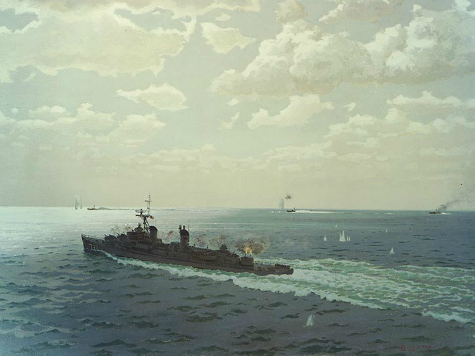
There will be no celebrations today for the fifty-year anniversary of the August 4, 1964 Gulf of Tonkin Incident. The aftermath of the Incident still divides America today.
At 11:00 p.m. Vietnam time, Commander John J. Herrick on the destroyer USS Maddox reported that his ship was under torpedo attack by North Vietnamese PT boats in what was deemed to be the first attack on a U.S. warship since WWII. Two days earlier, the Maddox had engaged three North Vietnamese PT boats making aggressive moves. The incident gave the Johnson administration the “justification” to convince all but two members of Congress to pass a joint resolution of support for military escalation on August 7, 1964.
On August 1st South Vietnamese raiders struck at two targets on the North Vietnamese coast, and the Laotian Air Force bombed infiltration routes along their border with the North as part of a U.S. plan of graduated covert pressure against the North that was known as Operations Plan (OPLAN)-34A. The Maddox’s Commander Herrick was not made aware of this activity.
The Maddox was actually on an intelligence mission off the northern coast, carrying surveillance communications and electronics gear along with a complement of specialists from the Naval Security Group, the naval complement to the National Security Agency. Their task was to intercept North Vietnamese communications. The spy ship was in international waters but had been inside territorial waters claimed by North Vietnam when it intercepted Hanoi’s PT boats being sent out by the local commander. In the ensuing battle two of the three boats were sunk and the third badly damaged, with no losses to the Maddox.
According to an interview with Daniel Ellsberg, who published the “Pentagon Papers” exposing Kennedy’s and Johnson’s run up to the Vietnam War, the U.S. military had already developed plans to attack North Vietnam if it challenged any U.S. naval assets. On August 1st, the North Vietnamese government had protested attacks on its territory by Laotian aircraft and South Vietnamese gunboats. Secretary of Defense Robert McNamara went to the White House to be with President Johnson at about 10:00 a.m. Washington, D.C., time, as the Gulf of Tonkin events unfolded fourteen time zones away.
Commander Herrick first reported one torpedo was launched at his ship. In the supposed two-hour engagement that followed, Herrick sent a number of cables reporting another 19 torpedoes had been launched at the Maddox. Later the next day, he would disavow reports of the other 19 torpedoes as due to “freak weather effects… almost total darkness” and an “overeager sonarman” who “was hearing [the] ship’s own propeller beat” against the wake as the Maddox took hard turns in evasive action.
The Pentagon released an afternoon press statement that a second attack by North Vietnamese PT boats had occurred in the Tonkin Gulf. President Lyndon Baines Johnson interrupted television programing that evening for an address to the nation announcing he had dispatched U.S. warplanes against the attackers and intended to ask Congress to pass a resolution to support his military actions. The Washington Post reported the following morning that “American Planes Hit North Vietnam After Second Attack on Our Destroyers; Move Taken to Halt New Aggression.”
Johnson’s August 4th address won accolades from editorial writers. The President, proclaimed the New York Times, “went to the American people last night with the somber facts.” The Los Angeles Times urged Americans to “face the fact that the Communists, by their attack on American vessels in international waters, have themselves escalated the hostilities.”
The House and the Senate on August 7th jointly passed the Gulf of Tonkin Resolution stating “Congress approves and supports the determination of the President, as Commander in Chief, to take all necessary measures to repeal any armed attack against the forces of the United States and to prevent any further aggression.” The only two members of Congress who dissented were Senators Wayne Morse and Ernest Gruening.
One of the Navy pilots flying overhead on the night of the Gulf of Tonkin Incident was A-6 squadron commander James Stockdale, who would later gain fame as the highest-ranking POW in the Hanoi Hilton and as Ross Perot’s vice presidential candidate. “I had the best seat in the house to watch that event,” recalled Stockdale a few years ago, “and our destroyers were just shooting at phantom targets – there were no PT boats there…. There was nothing there but black water and American fire power.”
President Lyndon Johnson in 1965 commented about the Gulf of Tonkin Incident: “For all I know, our Navy was shooting at whales out there.”
U.S. troop strength in South Vietnam rose from 23,300 in 1964 to 536,100 by 1968. On March 31, 1968, President Johnson with his political career in shambles said, “I shall not seek, and I will not accept, the nomination of my party for another term as your President.” Total U.S. casualties in the Vietnam War were 58,220 killed and 303,644 wounded. The last Americans killed were Marine Security Guard Battalion members Charles McMahon and Darwin Lee Judge on April 29, 1975 at the US Embassy in Saigon.

COMMENTS
Please let us know if you're having issues with commenting.